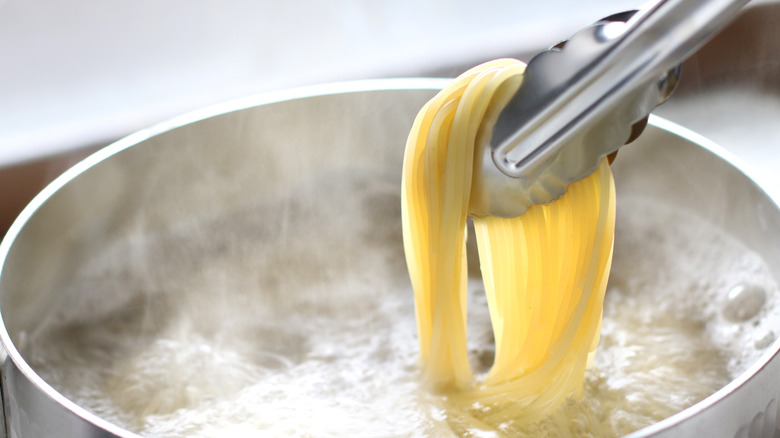Gordon Ramsay Doesn't Fully Drain Pasta And Neither Should You
You can always rely on Gordon Ramsay to point you in the right direction when it comes to cooking (even if that means he has to throw your dish in the garbage, a la "Hell's Kitchen"). And while you probably associate the famously hot-tempered chef more with fine dining than home cooking (he's a multiple Michelin star recipient, after all), let it be known that he also likes bringing star power to everyday dishes like tomato soup, salad, avocado toast, and pasta. In fact, Ramsay has one particular trick up his sleeve that he believes you should be using when preparing the latter — and that's only partially draining it.
In a video for his official Gordon Ramsay YouTube channel, the chef can be seen swiftly moving cooked pasta from a pot of boiling water with tongs — pausing only briefly to give it a slight jiggle — into a neighboring pan containing sauce; no sieves, colanders, or other draining equipment in sight. "Don't over-drain the pasta, leave the momentum of that in," he says. "I want some water shaken in there," he later adds. The idea of not properly draining pasta may seem unconventional to some, but it actually has a number of benefits — including the fact that it can help thicken and emulsify the accompanying sauce.
The case for partially draining pasta
The thickening and emulsifying aspect alone makes Gordon Ramsay's pasta tip worth trying. This is a result of starch — released into the water as the pasta cooks — reacting with fats and oils in the sauce to create a smooth, more substantial finish. Compare this to pasta dishes you may have encountered where the sauce is thin and watery, or has even separated; this generally occurs when cooked pasta has been rinsed or drained (essentially removing the starch). Furthermore, any starch remaining on the pasta itself will cause the sauce to cling to it, making for a more evenly distributed coating and some say, a better eating experience.
When it comes to actioning Ramsay's tip, we have a few extra words of wisdom. Be sure to use long-handled tongs or perhaps a pasta fork if you're dealing with the likes of fettuccine, spaghetti, or linguine (use a spider for shorter varieties such as penne); and don't be overly zealous when giving it the Ramsay jiggle (you don't want to lose any of those precious juices nor burn yourself with them!). Last, take care to add just a little pasta at a time to the sauce, giving it a proper chance to blend. Follow these simple steps, and you'll know Ramsay's word is indeed gospel when it comes to the matter of only partially draining pasta.

